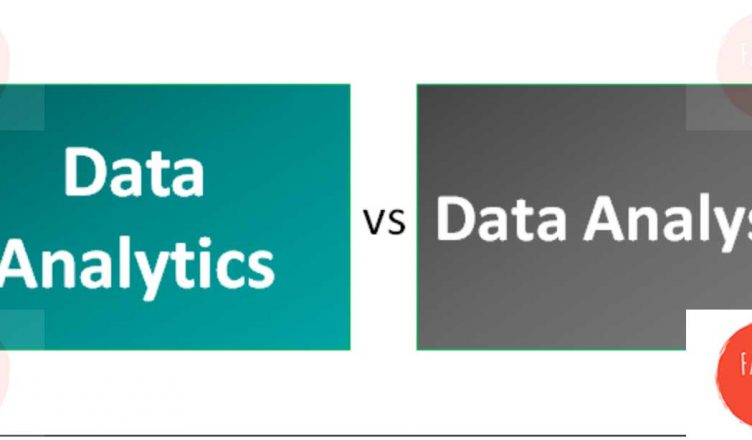Data Analysis and Data Analytics are the fields in which people usually conclude that they are the same. If you are among the individuals who are confused between data analytics and data analysis, you have landed on the right page. Data analytics is such a term in which data analysis practices are included, and hence they are on similar lines but not the same.
The article is divided into two sections. In the first section, we shall discuss data analysis in detail and data analytics in detail in the second section. At the end of this article, you will be having a clear idea about how both these fields differ. If you are an enthusiast, you will also decide if you wish to pursue data analysis or data analytics.
Understanding Data Analysis
Data analysis is a set of processes that include cleaning, sorting, and transforming the data to model and curate useful information that will be beneficial for the organization’s business decision-making. Let us consider a daily life example. Whenever we want to purchase any product, we consider the experience we had in the past with the same product; we consider what will happen if we get that product. It means nothing but to make a current decision, consider factors like past and future to keep the present smooth. It is as good as analyzing, where the data is our memories. On a similar line, when the same process is carried out in business, it is data analysis.
How does Data Analysis help?
When you wish to grow in your life, when you want to develop a business, analysis is a must! Notably, data analysis. When a company is stuck and does not grow, it is advisable to look into the past. Also, they need to acknowledge the mistakes made and try to fix it all by planning all over again. Data analysis will help the company to decide what strategies are to be implemented to grow the business.
What are the tools used for data analysis?
The eight most used data analysis tools are XPlenty, Microsoft HDInsight, Skytree, Talend, Splice machine, Apache Spark, R programming, and IBM SPSS Modeler.
Techniques in Data Analysis
Based on the business and technology, there are many data analysis techniques. We shall discuss the most used data analysis methods and techniques.
- Text Analysis: Text analysis, also known as data mining, is how a pattern is discovered from extensive data using data mining tools or databases. The raw data is transformed into a business ready information.
- Statistical Analysis: The statistical analysis is the one which answers to “what happens?” using the data from the past. It is a process in which data is analyzed, presented, interpreted, and modeled. It is generally divided into two types – Inferential Analysis and Descriptive Analysis.
- Diagnostic Analysis: The diagnostic analysis uses the insights obtained from statistical analysis to answer, “why happened?”. Whenever a new problem arises, a similar pattern can be searched for in the insights to produce the solution. In short, the analysis of the diagnostic identifies the design and behavior of the data.
- Predictive Analysis: As the name suggests, the predictive analysis predicts “what will happen?” using previous data insights. The accuracy of this analysis depends on how an in-depth study has been made. This type of research uses the data from the past to tell future outcomes.
- Prescriptive Analysis: To decide which solution is to be used for a specific problem, the prescriptive analysis uses all the above methods’ insights. To improve data performance, predictive or diagnostics analysis alone is not enough. Hence, most of the companies prefer prescriptive analysis.
Data Analytics in Brief
In data analytics, the raw data is processed to make the conclusions out of that information. Data analytics encompasses a variety of data analysis techniques. Any data can be subjected to data analytics to get useful information out of it.
Why Data Analytics?
Various data analytics tools can be used if you are planning to derive insightful information and parse data. Data analytics is required because even relational database systems and data warehouse could not handle the data handling and computational challenges. If you are a data analytics enthusiast, you should look for data analyst certification, which will help you become a successful data analyst.
Tools used for Data Analytics
There are many tools in the Big Data analytics domain, among which few are: Apache Spark, Python, SAS, Hadoop, SQL, Tableau, Splunk, R programming, etc. If you want to master all the tools, the data analyst certification is suggested.
Data Analytics working
Data analytics is a vast topic, and hence there are vast opportunities and possibilities.
- Data Requirement: It is essential to know the aim and vision behind the data requirement. It is also necessary to know which type of analysis is to be performed.
- Data Collection: Once the data requirement goal is known, it will be easy to know which data is found and worked upon. Now, depending upon the requirement, the information is collected. This collected data is to be organized and processed before organizing.
- Data Cleaning: Once the data is collected, it is crucial to clean the data as many data can be irrelevant for use. The data might also contain white spaces, duplicate records or errors. The data is to be cleared to make it error-free. This phase directly impacts the outcome of the analysis, and hence it should be done precisely and before performing the analysis.
- Data Interpretation: Once the data is analyzed, it is up to the analyst to decide how the insight is communicated. It could be either in charts, tables, or only words. The result obtained from this can be used to select the best solution for growing the business.
- Data Visualization: The outcomes of the data need to be communicated into human- brain understandable form. The data thus can be represented graphically using graphs and charts. Data visualization is used to discover the trends and facts which are unknown. Meaningful information can be found out of the processed data, which can help organizations.
We shall conclude by saying that data analysis is a subset of data analytics since a wide range of data analysis techniques comes under data analytics. The data analyst certification will make it easy to lay a career in this field under industry-level experts’ guidance.

